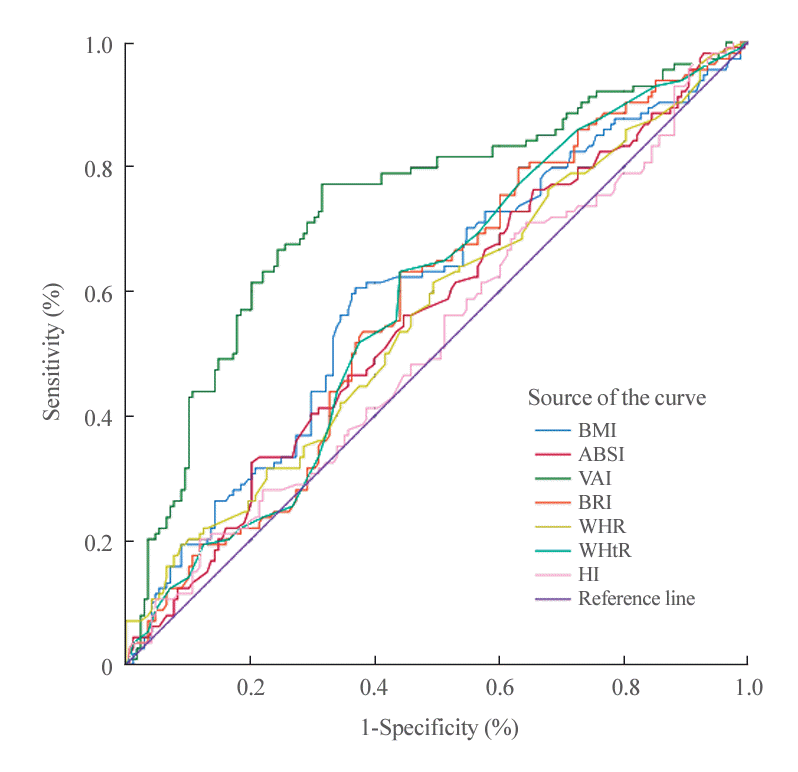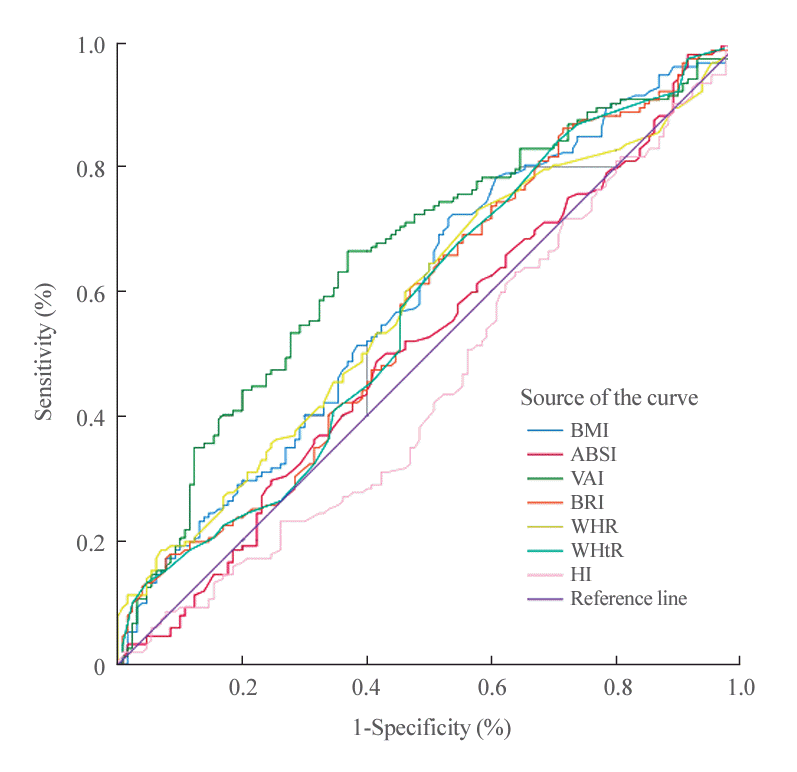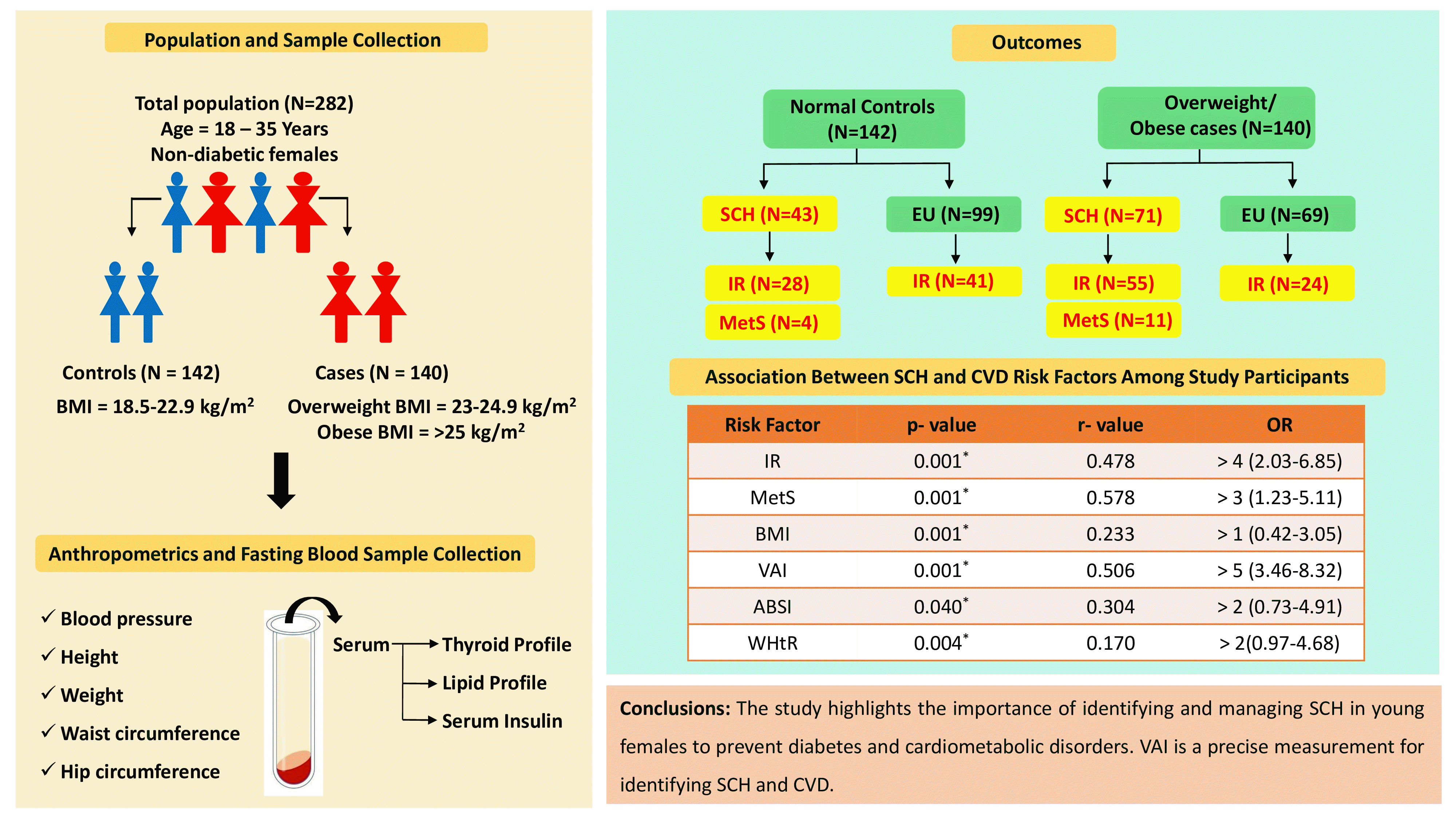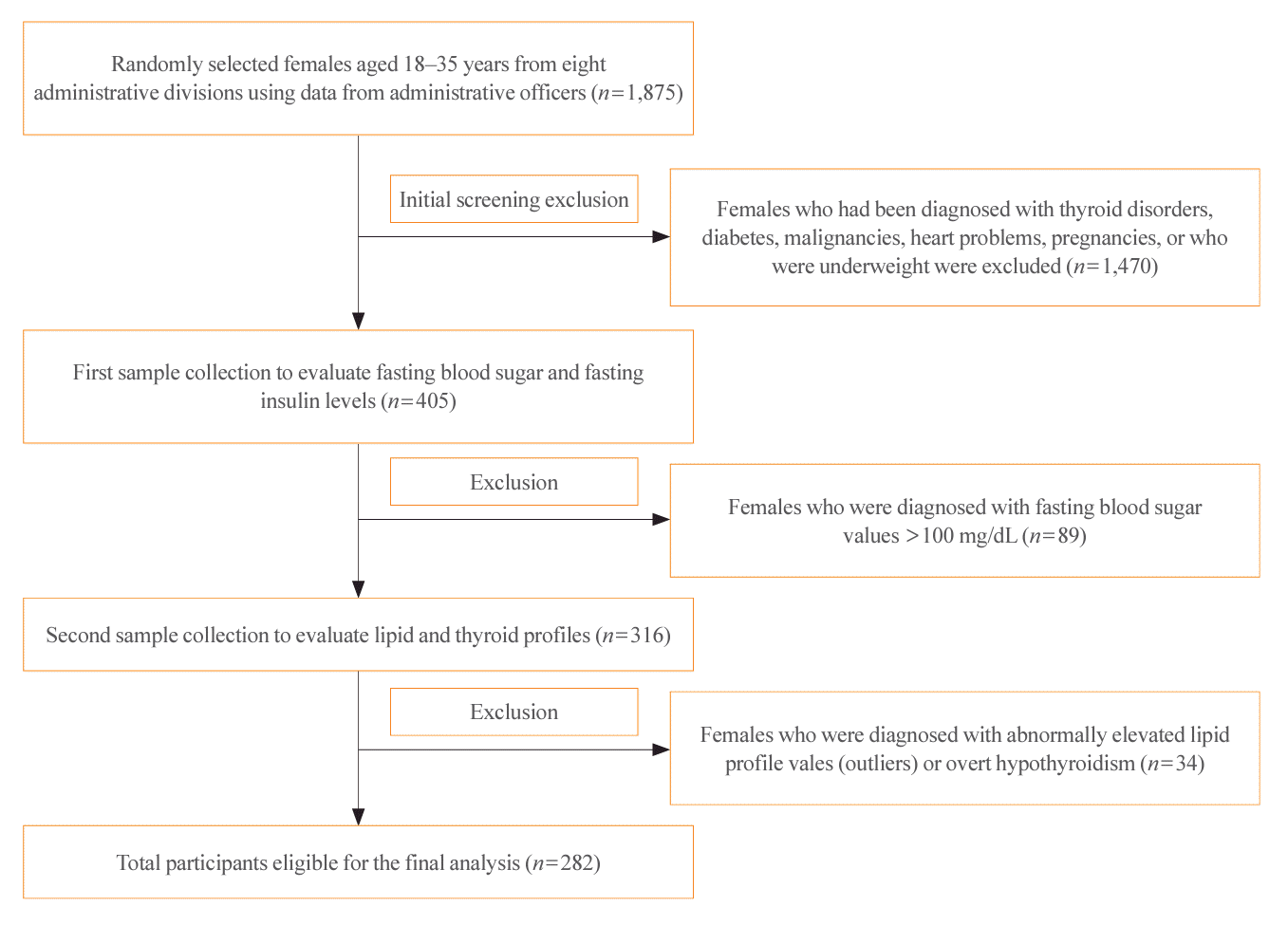1. Biondi B, Cooper DS. The clinical significance of subclinical thyroid dysfunction. Endocr Rev. 2008; 29:76–131.
2. Vanderpump MP. The epidemiology of thyroid disease. Br Med Bull. 2011; 99:39–51.
3. Pekgor S, Duran C, Kutlu R, Solak I, Pekgor A, Eryilmaz MA. Visceral adiposity index levels in patients with hypothyroidism. J Natl Med Assoc. 2018; 110:606–13.
4. Wilcox G. Insulin and insulin resistance. Clin Biochem Rev. 2005; 26:19–39.
5. Reaven G. The metabolic syndrome or the insulin resistance syndrome: different names, different concepts, and different goals. Endocrinol Metab Clin North Am. 2004; 33:283–303.
6. Enzevaei A, Salehpour S, Tohidi M, Saharkhiz N. Subclinical hypothyroidism and insulin resistance in polycystic ovary syndrome: is there a relationship? Iran J Reprod Med. 2014; 12:481–6.
7. Eckel RH, Grundy SM, Zimmet PZ. The metabolic syndrome. Lancet. 2005; 365:1415–28.
8. Amarasekara P, de Silva A, Swarnamali H, Senarath U, Katulanda P. Knowledge, attitudes, and practices on lifestyle and cardiovascular risk factors among metabolic syndrome patients in an urban tertiary care institute in Sri Lanka. Asia Pac J Public Health. 2016; 28(1 Suppl):32S–40S.
9. Tsou MT. Subclinical hypothyroidism represents visceral adipose indices, especially in women with cardiovascular risk. J Endocr Soc. 2021; 5:bvab028.
10. Aziz M, Kandimalla Y, Machavarapu A, Saxena A, Das S, Younus A, et al. Effect of thyroxin treatment on carotid intima-media thickness (CIMT) reduction in patients with subclinical hypothyroidism (SCH): a meta-analysis of clinical trials. J Atheroscler Thromb. 2017; 24:643–59.
11. Amato MC, Giordano C, Galia M, Criscimanna A, Vitabile S, Midiri M, et al. Visceral adiposity index: a reliable indicator of visceral fat function associated with cardiometabolic risk. Diabetes Care. 2010; 33:920–2.
12. Cercato C, Fonseca FA. Cardiovascular risk and obesity. Diabetol Metab Syndr. 2019; 11:74.
13. Freedman DS, Ogden CL, Berenson GS, Horlick M. Body mass index and body fatness in childhood. Curr Opin Clin Nutr Metab Care. 2005; 8:618–23.
15. Hsieh SD, Yoshinaga H. Abdominal fat distribution and coronary heart disease risk factors in men-waist/height ratio as a simple and useful predictor. Int J Obes Relat Metab Disord. 1995; 19:585–9.
16. Ashwell M, Lejeune S, McPherson K. Ratio of waist circumference to height may be better indicator of need for weight management. BMJ. 1996; 312:377.
17. Krakauer NY, Krakauer JC. A new body shape index predicts mortality hazard independently of body mass index. PLoS One. 2012; 7:e39504.
18. Krakauer NY, Krakauer JC. An anthropometric risk index based on combining height, weight, waist, and hip measurements. J Obes. 2016; 2016:8094275.
20. Evans K, Mitcheson J, Laker MF. Effect of storage at -70 degrees C on lipid, lipoprotein and apolipoprotein concentrations. Clin Chim Acta. 1997; 258:219–29.
21. Nwosu OK, Nwani CD. Stability of serum/plasma glucose for the diagnosis of diabetes mellitus. Bio Res. 2008; 6:380–3.
22. Nishi I, Okada Y, Hayashi J, Takeoka K, Amino N, Miyai K. Effect of various sampling condition on the measurement of circulating TSH and free thyroxine. Rinsho Byori. 1992; 40:417–22.
23. WHO Expert Consultation. Appropriate body-mass index for Asian populations and its implications for policy and intervention strategies. Lancet. 2004; 363:157–63.
24. Misra A, Chowbey P, Makkar BM, Vikram NK, Wasir JS, Chadha D, et al. Consensus statement for diagnosis of obesity, abdominal obesity and the metabolic syndrome for Asian Indians and recommendations for physical activity, medical and surgical management. J Assoc Physicians India. 2009; 57:163–70.
25. Yoo EG. Waist-to-height ratio as a screening tool for obesity and cardiometabolic risk. Korean J Pediatr. 2016; 59:425–31.
26. Wang F, Chen Y, Chang Y, Sun G, Sun Y. New anthropometric indices or old ones: which perform better in estimating cardiovascular risks in Chinese adults. BMC Cardiovasc Disord. 2018; 18:14.

27. Kim B, Kim GM, Kim E, Park J, Isobe T, Mori Y, et al. The anthropometric measure ‘a body shape index’ may predict the risk of osteoporosis in middle-aged and older Korean people. Int J Environ Res Public Health. 2022; 19:4926.
28. Oh JY, Sung YA, Lee HJ. The visceral adiposity index as a predictor of insulin resistance in young women with polycystic ovary syndrome. Obesity (Silver Spring). 2013; 21:1690–4.

29. Konstantynowicz J, Abramowicz P, Jamiolkowski J, Kadziela-Olech H, Bialokoz-Kalinowska I, Kierus-Jankowska K, et al. Thigh circumference as a useful predictor of body fat in adolescent girls with anorexia nervosa. Ann Nutr Metab. 2011; 58:181–7.
30. Jonklaas J, Bianco AC, Bauer AJ, Burman KD, Cappola AR, Celi FS, et al. Guidelines for the treatment of hypothyroidism: prepared by the American Thyroid Association Task Force on Thyroid Hormone Replacement. Thyroid. 2014; 24:1670–751.
31. Singh Y, Garg MK, Tandon N, Marwaha RK. A study of insulin resistance by HOMA-IR and its cut-off value to identify metabolic syndrome in urban Indian adolescents. J Clin Res Pediatr Endocrinol. 2013; 5:245–51.
32. Alberti KG, Eckel RH, Grundy SM, Zimmet PZ, Cleeman JI, Donato KA, et al. Harmonizing the metabolic syndrome: a joint interim statement of the International Diabetes Federation Task Force on Epidemiology and Prevention; National Heart, Lung, and Blood Institute; American Heart Association; World Heart Federation; International Atherosclerosis Society; and International Association for the Study of Obesity. Circulation. 2009; 120:1640–5.
33. Meier C, Staub JJ, Roth CB, Guglielmetti M, Kunz M, Miserez AR, et al. TSH-controlled L-thyroxine therapy reduces cholesterol levels and clinical symptoms in subclinical hypothyroidism: a double blind, placebo-controlled trial (Basel Thyroid Study). J Clin Endocrinol Metab. 2001; 86:4860–6.

34. Perros P, McCrimmon RJ, Shaw G, Frier BM. Frequency of thyroid dysfunction in diabetic patients: value of annual screening. Diabet Med. 1995; 12:622–7.
35. Handisurya A, Pacini G, Tura A, Gessl A, Kautzky-Willer A. Effects of T4 replacement therapy on glucose metabolism in subjects with subclinical (SH) and overt hypothyroidism (OH). Clin Endocrinol (Oxf). 2008; 69:963–9.

36. Kordonouri O, Klinghammer A, Lang EB, Gruters-Kieslich A, Grabert M, Holl RW. Thyroid autoimmunity in children and adolescents with type 1 diabetes: a multicenter survey. Diabetes Care. 2002; 25:1346–50.
37. Weerakkody RM, Lokuliyana PN. Severe hypothyroidism presenting as reversible proteinuria: two case reports. J Med Case Rep. 2019; 13:270.

38. Alsulami SS, Baig M, Albeladi AH, Alyoubi SB, Alsubaie SA, Albeladi SA, et al. Correlation between subclinical hypothyroidism and metabolic syndrome: a retrospective study. Saudi J Med Med Sci. 2023; 11:250–6.

39. Diez JJ, Iglesias P. Prevalence of diabetes in people with thyroid dysfunction. Med Clin (Barc). 2023; 160:333–40.

40. Tuomi T, Groop LC, Zimmet PZ, Rowley MJ, Knowles W, Mackay IR. Antibodies to glutamic acid decarboxylase reveal latent autoimmune diabetes mellitus in adults with a non-insulin-dependent onset of disease. Diabetes. 1993; 42:359–62.

41. Kouidhi S, Berhouma R, Ammar M, Rouissi K, Jarboui S, Clerget-Froidevaux MS, et al. Relationship of thyroid function with obesity and type 2 diabetes in euthyroid Tunisian subjects. Endocr Res. 2013; 38:15–23.

42. Rastgooye Haghi A, Solhjoo M, Tavakoli MH. Correlation between subclinical hypothyroidism and dyslipidemia. Iran J Pathol. 2017; 12:106–11.

43. Ejaz M, Kumar P, Thakur M, Bachani P, Naz S, Lal K, et al. Comparison of lipid profile in patients with and without subclinical hypothyroidism. Cureus. 2021; 13:e17301.

44. Reinehr T, de Sousa G, Andler W. Hyperthyrotropinemia in obese children is reversible after weight loss and is not related to lipids. J Clin Endocrinol Metab. 2006; 91:3088–91.

45. Biondi B. Thyroid and obesity: an intriguing relationship. J Clin Endocrinol Metab. 2010; 95:3614–7.

46. Chomard P, Vernhes G, Autissier N, Debry G. Serum concentrations of total T4, T3, reverse T3 and free T4, T3 in moderately obese patients. Hum Nutr Clin Nutr. 1985; 39:371–8.
47. Polat Canbolat I, Belen E, Bayyigit A, Helvaci A, Kilickesmez K. Evaluation of daily blood pressure alteration in subclinical hypothyroidism. Acta Cardiol Sin. 2017; 33:489–94.






 PDF
PDF Citation
Citation Print
Print





 XML Download
XML Download